

Prince Harry plays wheelchair footy and learns bush survival during stint with Australian army. The British army captain better known as Prince Harry has played wheelchair AFL and learned bush survival techniques during his first fortnight with the Australian army.

The 30-year-old veteran of two Afghanistan deployments is on a month-long military exchange to Australia. His schedule in the Northern Territory with the 1st Brigade has included flight simulation training, riding in an armed reconnaissance helicopter (Tiger), physical training and preparing for field exercises. But it hasn’t been all work and no play for the prince. After meeting with wounded and injured Australian soldiers he joined a game of wheelchair footy. Earlier, while on duty with the North-West Mobile Force he got a lesson in bush survival and sourcing food and water, camping out two nights in the remote Kununurra region in Western Australia.
He also met local Indigenous children and elders at the community of Wuggubun. He’ll resume his stint with Australian army joining units in Perth and Sydney upon his return. Structure of the Australian Army. This article describes the current structure of the Australian Army.
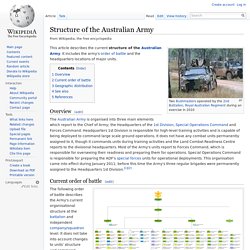
It includes the army's order of battle and the headquarters locations of major units. Overview[edit] Current order of battle[edit] The Australian Army's structure in 2012 Geographic distribution[edit] LAND 400 and the future of Army. While high profile Defence projects like the Joint Strike Fighter and future submarine have received plenty of coverage, much less has been written about LAND 400—a proposed $10 billion purchase of armoured land combat vehicles for Army.
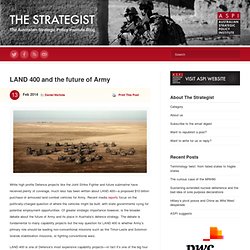
Recent media reports focus on the politically-charged question of where the vehicles might be built, with state governments vying for potential employment opportunities. LAND 400 PHASE 2 – LAND COMBAT VEHICLE SYSTEM (LCVS) – Part 1. LAND 400 PHASE 2 – LAND COMBAT VEHICLE SYSTEM (LCVS) – Part 1 Byline: Geoff Slocombe / Victoria At the 13 February 2013 hearing of the Senate’s Foreign Affairs, Defence and Trade Legislation Committee, Senator Fawcett asked Lieutenant General David Morrison “Chief of Army, to conclude our discussion.
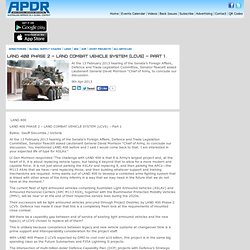
You mentioned LAND 400 before and I said I would come back to that. I am interested in your expected life of type for ASLAV.” Lt Gen Morrison responded “The challenge with LAND 400 is that it is Army's largest project and, at the heart of it, it is about replacing vehicle types, but taking it beyond that to allow for a more modern and capable force. Project LAND 400. Army’s core business is the conduct of sustained close combat.
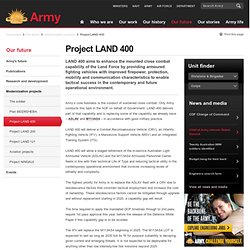
Only Army conducts this task in the ADF on behalf of Government. LAND 400 delivers part of that capability and is replacing some of the capability we already have – ASLAV and M113AS4 – in accordance with good military practice. Fort Queenscliff. Coordinates: The first Allied shots of World War I were fired when a gun at Fort Nepean fired across the bow of the German freighter Pfalz, as she was attempting to escape to sea.[1] The orders to fire came from Fort Queenscliff.
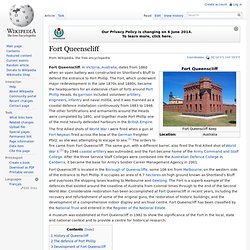
The same gun, with a different barrel, also fired the first Allied shot of World War II.[1] By 1946 coastal artillery was outmoded, and the Fort became home of the Army Command and Staff College. After the three Service Staff Colleges were combined into the Australian Defence College in Canberra, it became the base for Army's Soldier Career Management Agency in 2001. Fort Queenscliff is located in the Borough of Queenscliffe, some 106 km from Melbourne, on the western side of the entrance to Port Phillip. It occupies an area of 6.7 hectares on high ground known as Shortland's Bluff and overlooks the shipping lanes leading to Melbourne and Geelong. M72 LAW. The M72 LAW (Light Anti-Tank Weapon, also referred to as the Light Anti-Armor Weapon or LAW as well as LAWS Light Anti-Armor Weapons System) is a portable one-shot 66 mm unguided anti-tank weapon.
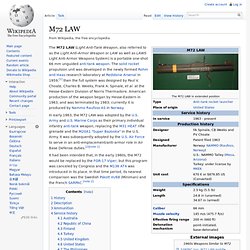
The solid rocket propulsion unit was developed in the newly formed Rohm and Haas research laboratory at Redstone Arsenal in 1959,[1] then the full system was designed by Paul V. Choate, Charles B. Weeks, Frank A. Spinale, et al. at the Hesse-Eastern Division of Norris Thermadore. American production of the weapon began by Hesse-Eastern in 1963, and was terminated by 1983; currently it is produced by Nammo Raufoss AS in Norway. In early 1963, the M72 LAW was adopted by the U.S. Special Operations Engineer Regiment (Australia) The Special Operations Engineer Regiment (SOER) can trace its history to a number of specialist Royal Australian Engineers organisations - The Emergency Response Squadron was initially formed in 1999 from the existing Army Fire Service in response to the 1996 Blackhawk Helicopter disaster in the Townsville High Range training area.
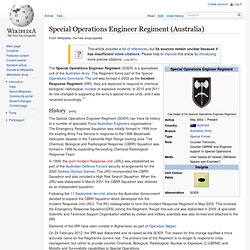
The Chemical, Biological and Radiological Response (CBRR) Squadron was formed in 1999 by expanding the existing Chemical Radiological Response Team. Tactical assault group. History[edit] An Army Black Hawk helicopter simulating counter-terrorism scenarios at Sydney Olympic Park, 2008.
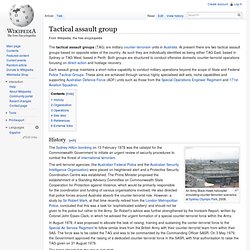
The Sydney Hilton bombing on 13 February 1978 was the catalyst for the Commonwealth Government to initiate an urgent review of security procedures to combat the threat of international terrorism. The anti-terrorist agencies (the Australian Federal Police and the Australian Security Intelligence Organisation) were placed on heightened alert and a Protective Security Coordination Centre was established. The Prime Minister proposed the establishment of a Standing Advisory Committee on Commonwealth State Cooperation for Protection against Violence, which would be primarily responsible for the coordination and funding of various organisations involved.
He also directed that police forces around Australia absorb the counter-terrorist role. Seahorse Mercator. Design and construction[edit] Seahose Mercator is a variant of the Pacific class patrol boat design.[1] The ship has a displacement of 165 tons, a length of 31.5 metres (103 ft), a beam of 8.21 metres (26.9 ft), and a draught of 2.6 metres (8 ft 6 in).[1] Propulsion is supplied by two Caterpillar 3304 diesels, driving two propellers.[1] Maximum speed is 16 knots (30 km/h; 18 mph), with a range of 2,880 nautical miles (5,330 km; 3,310 mi) at 8 knots (15 km/h; 9.2 mph).[1] Seahorse Mercator is run by a crew of five plus three instructors, and can carry up to eighteen trainees.[1] Radars include a Furuno FE 606 navigation radar, and a Decca Bridgemaster ARPA navigation radar.[1] The vessel is unarmed.[2]

13th Brigade. 13th Brigade From Wikipedia, the free encyclopedia Jump to: navigation, search 13th Brigade may refer to: Contents [hide] 2nd Division. Urban operations facility training shoalwater bay training area. Special operations vehicle direct action. Supacat - High Mobility and All Terrain Vehicles - Supacat. Supacat hmt. Nary special operations vehicle. Supacat - High Mobility and All Terrain Vehicles - Supacat. Adf townsend island weapons range. Bined arms training activity townsville. Sniper rifle. Bor – the 7.62×51 mm Polish bolt-action sniper rifle. The military role of a sniper (a term derived from the snipe, a bird which was difficult to hunt and shoot) dates back to the turn of the 18th century, but the true sniper rifle is a much more recent development.
Advances in technology, specifically that of telescopic sights and more accurate manufacturing, allowed armies to equip specially trained soldiers with rifles that enable them to deliver precise shots over greater distances than regular infantry weapons. The rifle itself could be based on a standard rifle (at first, a bolt-action rifle); however, when fitted with a telescopic sight, it becomes a sniper rifle. Accuracy International AWM. The Accuracy International AWM (Arctic Warfare Magnum) is a bolt-action sniper rifle manufactured by Accuracy International designed for magnum rifle cartridge chamberings.
The Accuracy International AWM is also unofficially known as the AWSM (Arctic Warfare Super Magnum), which typically denotes AWM rifles chambered in .338 Lapua Magnum. PGM Hécate II. The Hecate II is the standard heavy sniper rifle of the French Army, sometimes known as the FR-12,7 (French: 'Fusil à Répétition de calibre 12.7 mm or "12.7 mm caliber bolt-action rifle"). Manufacture[edit] It is manufactured by PGM Précision of France. This is the largest weapon manufactured by PGM, chambered for the .50 BMG (12.7x99mm NATO) cartridge. Design[edit] FR F2 sniper rifle. The FR F2 (French: Fusil à Répétition modèle F2; English: Bolt-action Rifle, F2 model) is the standard sniper rifle of the French military.
It is designed for shooting at point targets at distances up to 800 meters. Design[edit] The FR-F2 is an upgrade from the earlier FR F1 sniper rifle. It was manufactured by MAS (an abbreviation of Manufacture d'armes de Saint-Étienne - one of several government-owned arms factories in France). MAS now belongs to GIAT Industries, now NEXTER. Adf cultana training are. M24 Sniper Weapon System. IDF M24 SWS with Leopold scope and bipod. CM-32 Armoured Vehicle. AS-90. Panzerhaubitze 2000. Sniper. A sniper is a highly trained marksman who operates alone, in a pair, or with a sniper team to maintain close visual contact with the enemy and engage targets from concealed positions or distances exceeding the detection capabilities of enemy personnel. These sniper teams operate independently, with little combat asset support from their parent units. Snipers typically have highly selective and specialized training and use high-precision/special application rifles and optics, and often have sophisticated communication assets to feed valuable combat information back to their units.
In addition to marksmanship, military snipers are trained in camouflage, field craft, infiltration, special reconnaissance and observation, surveillance and target acquisition.[1] Snipers are especially effective when deployed within the terrain of urban warfare, or jungle warfare. Self-propelled artillery. In the past, self-propelled artillery has included direct-fire vehicles such as assault guns and tank destroyers. Israeli merkava. Fv101 scorpion. Enoggera Barracks. History[edit] The base has a long history, having been in existence officially since 1908, although the wider area has been used for military purposes since 1855.[2] Upon its establishment, the camp consisted of four paddocks that were used for training and drill—Bell, Fraser's, Rifle and Thompson's—and a number of rifle ranges were established there for use by civilian groups and units of the militia.
Army: Army Bases - Defence Jobs Australia. Land combat readiness centre. Lone Pine Barracks. Lone Pine Barracks is an Australian Army base located in New South Wales, 8 kilometres (5.0 mi) south of Singleton. Adf plan beersheba. Puckapunyal. Senior officers on horseback at Puckapunyal in 1940. Mag 58. Army Recruit Training Centre. Australian Army. List of Australian Army Cadet units. 5th Battalion, Royal Australian Regiment. 8th/12th Regiment, Royal Australian Artillery. 1st Combat Engineer Regiment. 1st Brigade. Larrakeyah Barracks. 51st Battalion, Far North Queensland Regiment. Pilbara Regiment. NORFORCE. Regional Force Surveillance Units. Rifle Company Butterworth. Australian Army Recruit Training. Recruit training. 1st/19th Battalion, Royal New South Wales Regiment. 7th Battalion, Royal Australian Regiment. LAV III.
M240 machine gun. FN MAG. L1A1 Self-Loading Rifle. Steyr AUG. FN Minimi. Blowpipe (missile) FIM-92 Stinger. M252 mortar. Royal Australian Engineers. M1 helmet. M60 machine gun. Personnel Armor System for Ground Troops. Enhanced Combat Helmet. Opposing force. Disruptive Pattern Combat Uniform. Future Force Warrior. MultiCam. Brigade of Gurkhas. Mk 6 helmet. Modern equipment of the British Army. 81 KRH 71 Y. Future Combat Systems Manned Ground Vehicles.
M224 mortar. Wiesel AWC. AMOS. Soltam K6. Lightweight Armoured Mortar of Advanced Mortar System. Boeing AH-64 Apache. AR-15. Blowpipe (missile) Quad bike. Royal Australian Corps of Signals. 1st/15th Royal New South Wales Lancers. M249 light machine gun. Steyr AUG. FN Minimi. FN Minimi. Sayeret Matkal. Sayeret. Aérospatiale Gazelle. HOT (missile) BGM-71 TOW.